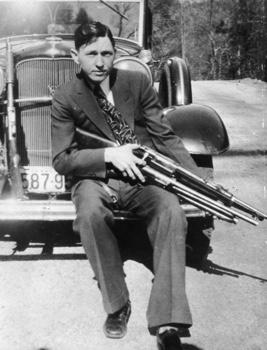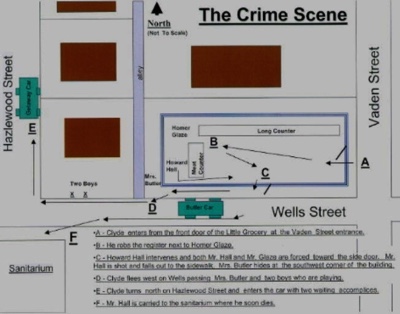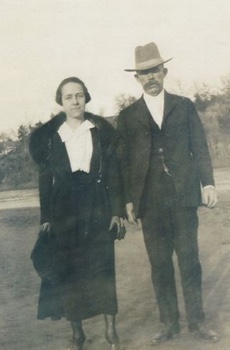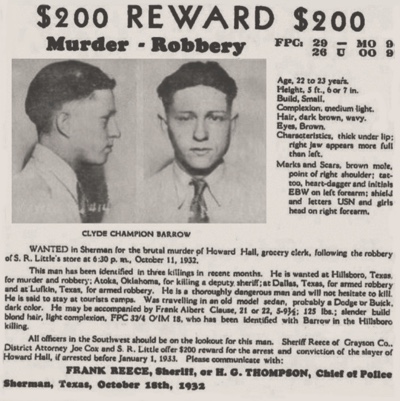“Damn,” said one of the men in the back of the room where the body of the hoodlum lay, “he was just a little bitty fart.” That may be the most correct assessment of Clyde Chestnut Barrow ever made. Millions of words, at least three motion pictures and scores of tales told by old men around small town squares over the years have inflated, to legendary proportions, the life and deeds of a small-time burglar turned car thief turned murderous stick-um-up guy and his equally jaded consort, Bonnie Parker.

In the twenty-seven months from the time of his pardon from the Texas prison system in February 1932, until he and his moll died on a Louisiana back road, Barrow and Parker and a changing gang of cohorts ranged over Texas, Oklahoma, and the Midwest pulling penny ante robberies and committing mayhem and murder. The biggest take the gang ever recorded was about $1,500.
Twelve people, six of whom were peace officers, were slain. The fourth of those twelve victims was a fifty-seven-year-old Sherman grocery clerk named Howard Hall, who worked behind the meat counter in the Sid Little Grocery and Market at 624 S. Vaden Street.
It was a little before 6:30 in the evening of October 11, 1932, when a black Buick sedan with Kansas tags stopped at the curb on Hazelwood Street near the grocery store. Clyde Barrow was in the driver’s seat with Hollis Hale beside him and Frank Hardy in the back. Bonnie Parker was not in the car.
The Sid Little Grocery was in a narrow building with entrances on Vaden and Wells streets. Along the north wall, ran a long counter ending at the meat market. The market was separated from the rest of the store by a glass display case at right angles to the counter with enough room to move in and out behind the case. The cash register was on the counter near the slot.

Homer Glaze, the store’s cashier, had finished sweeping up and was checking the day’s receipts, and Howard Hall was cleaning up in the meat market when Barrow walked into the store. He picked up a loaf of bread and then stopped at the counter near the register.
“He was a small man and looked about five feet six inches tall and weighted about 130 pounds,” Glaze told the Sherman Daily Democrat. “He was clean shaven and light complected (sic). He wore a gray felt hat, a tan lumber jacket and dark trousers. He appeared to be about 20 or 25 years old.”
Glaze asked if there would be anything else. “The man first called for a half a dozen eggs and then walked up to the meat counter and asked for a dime’s worth of lunch meat. Taking these, he handed me a dollar bill,” said Glaze. When the grocer opened the till, Barrow pulled out a .45 caliber pistol and announced he was holding up the place. With the pistol on Glaze, the robber reached into the cash drawer and pulled out about $60.

“At this point,” Glaze continued, “Mr. Hall advanced around the south end of the meat counter and said, ‘Young man, you can’t do that.’”
“With an oath, the bandit replied that he would show Mr. Hall whether he could or not. He then backed me out around the end of the counter and toward the center of the store and called Mr. Hall over to us.” Barrow pushed and cursed at the two men and herded them towards the Wells Street door.
Mrs. L. C. Butler was approaching the market when she saw the three men at the front entrance. She ran to the southeast corner of the building and watched the events unfolding in the doorway.
Stepping over the fallen man, the murder fired once more into the body before turning his attention to Homer Glaze. As Glaze moved to help his fallen friend, Barrow, at point blank range fired again, but nothing happened. The pistol either misfired, or was out of ammunition. At the corner of the store, Mrs. Butler bit her knuckle to keep from screaming as two small boys, playing at the corner, saw what had happened and dashed off after the police.
Frank Hardy stood by the back door of the getaway car trying to determine what had happened to produce the gunfire. Hollis Hale sat behind the wheel with the motor running. He slid over as Barrow dashed from the store and slipped into the driver’s seat, gunning the car as it roared away to pick up Parker and make their escape.
At first, the identity of the murderer was unknown, but Glaze eventually recognized a police photograph of Barrow and the connection established. In December the Grayson County Grand Jury returned two true bills, indicting Clyde Champion Barrow—they got the middle name wrong—with robbery and murder.

Eight victims latter, on May 23, 1934, Clyde Barrow and Bonnie Parker died in a storm of bullets on a back road in Bienville Parish, Louisiana, brought to justice by former Texas Ranger Captain Frank Hamer and other lawmen working on special duty for Director of the Texas Prison System, Lee Simmons. Simmons was a former sheriff of Grayson County.
At the close of the May term of court, the Grayson County District Attorney dismissed the outstanding indictments against Barrow. Scribbled across the paper he wrote, “Death suggested.”